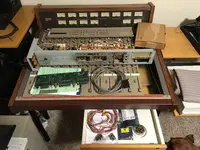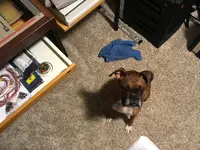sweetbeats
Reel deep thoughts...
Wellllll...
For the first time in just about 9 months the Tascam M-__ mixing console is housed indoors. In that time its been moved 4 times and lived for different periods in unheated non-insulated or air-conditioned spaces like a solarium, a shop, and a garage. I think it has survived its travels and dwellings unscathed except for a small nick in the wrist-rest upholstery...maybe a small dent or scuff on wood trim. Biggest challenge now is to re-trace my steps and try and remember where I left off.
The master module is currently a basket-case. I know I was having trouble with sputtering/popping in the headphone amp, and popping when engaging the MONO, DIM, and MUTE functions for the CONTROL ROOM output...the suspect was an array of JFETs that is repeated in many areas in the master module and in the I/O modules...the array makes an analog switch and IIRC I was going to shotgun all of them. But I know I was also in the midst of replacing/upgrading some key opamps in the I/O modules (in part because I had finally found the cause of an aggravating oscillation issue, but also "upgrading" some key stages), and I don't know where I left off with that, and I was doing some of the same in the master section...and likewise don't remember where I left off there either...and there was the headphone amp problem. I vaguely recall thinking I was going to have to fabricate some extender cables to be able to have the master section fully interfaced with the motherboard while out of the frame, but I can't remember exactly why. And I also recall I had spent a fair amount of time relocating a *really* janky opamp circuit on one of the master section boards to a more proper install in a vacant DIP-8 site on the same board (the IC, caps and resistors were hanging off the back side of another IC like an electronic granola-wart cluster...pure prototype kludge)...BUT...can't recall if that was all wrapped up or not. I recall having some trouble after the mods.
I know I have notes somewhere but I haven't found those yet with all the moving this last year. And I also know I have at least 3 collections of new and/or spare parts that had been gathered together for all the above work but I don't yet know where those are either. And hopefully when I find those I'll also find the hardware and cosmetics for the basket-case master section (screws, knob and switch caps, etc.)
I found a whole bunch of email threads with a friend of mine from 2014 that will be like a trail of bread crumbs for me and hopefully help me refresh my memory.
So close, yet so far...when I was reinstalling the I/O modules back in the frame last night after moving the frame into our office/music room, I had a flashback to...2008? Really?? Will it really be 8 YEARS this year since that cannonball run down to Burbank and back to snag this console?!? Anyway, as I put module #1 in last night I remembered...allllllll the mouse pee and poo that was all over everything in the back corner of the console when I got it...all the broken stuff...it was really neglected-looking. And no power supply at all. It is the pinnacle of my sweetbeats-edness with the cosmetics all done (including the custom solid walnut wood trim, paint touch-ups and polishing...added color coding of switches and knobs), and inside 100% recapped, pots and switches and boards cleaned...power supply rebuilt and upgraded...ground plane re-engineered...so many small repairs and upgrades to remember. Need to get the last bits done on the I/O modules (the opamp and JFET replacements), and figure out where I'm at with all the stuff on the master module.
Anyway, as I put module #1 in last night I remembered...allllllll the mouse pee and poo that was all over everything in the back corner of the console when I got it...all the broken stuff...it was really neglected-looking. And no power supply at all. It is the pinnacle of my sweetbeats-edness with the cosmetics all done (including the custom solid walnut wood trim, paint touch-ups and polishing...added color coding of switches and knobs), and inside 100% recapped, pots and switches and boards cleaned...power supply rebuilt and upgraded...ground plane re-engineered...so many small repairs and upgrades to remember. Need to get the last bits done on the I/O modules (the opamp and JFET replacements), and figure out where I'm at with all the stuff on the master module.
It'll get done eventually.
For the first time in just about 9 months the Tascam M-__ mixing console is housed indoors. In that time its been moved 4 times and lived for different periods in unheated non-insulated or air-conditioned spaces like a solarium, a shop, and a garage. I think it has survived its travels and dwellings unscathed except for a small nick in the wrist-rest upholstery...maybe a small dent or scuff on wood trim. Biggest challenge now is to re-trace my steps and try and remember where I left off.
The master module is currently a basket-case. I know I was having trouble with sputtering/popping in the headphone amp, and popping when engaging the MONO, DIM, and MUTE functions for the CONTROL ROOM output...the suspect was an array of JFETs that is repeated in many areas in the master module and in the I/O modules...the array makes an analog switch and IIRC I was going to shotgun all of them. But I know I was also in the midst of replacing/upgrading some key opamps in the I/O modules (in part because I had finally found the cause of an aggravating oscillation issue, but also "upgrading" some key stages), and I don't know where I left off with that, and I was doing some of the same in the master section...and likewise don't remember where I left off there either...and there was the headphone amp problem. I vaguely recall thinking I was going to have to fabricate some extender cables to be able to have the master section fully interfaced with the motherboard while out of the frame, but I can't remember exactly why. And I also recall I had spent a fair amount of time relocating a *really* janky opamp circuit on one of the master section boards to a more proper install in a vacant DIP-8 site on the same board (the IC, caps and resistors were hanging off the back side of another IC like an electronic granola-wart cluster...pure prototype kludge)...BUT...can't recall if that was all wrapped up or not. I recall having some trouble after the mods.
I know I have notes somewhere but I haven't found those yet with all the moving this last year. And I also know I have at least 3 collections of new and/or spare parts that had been gathered together for all the above work but I don't yet know where those are either. And hopefully when I find those I'll also find the hardware and cosmetics for the basket-case master section (screws, knob and switch caps, etc.)
I found a whole bunch of email threads with a friend of mine from 2014 that will be like a trail of bread crumbs for me and hopefully help me refresh my memory.
So close, yet so far...when I was reinstalling the I/O modules back in the frame last night after moving the frame into our office/music room, I had a flashback to...2008? Really?? Will it really be 8 YEARS this year since that cannonball run down to Burbank and back to snag this console?!?
 Anyway, as I put module #1 in last night I remembered...allllllll the mouse pee and poo that was all over everything in the back corner of the console when I got it...all the broken stuff...it was really neglected-looking. And no power supply at all. It is the pinnacle of my sweetbeats-edness with the cosmetics all done (including the custom solid walnut wood trim, paint touch-ups and polishing...added color coding of switches and knobs), and inside 100% recapped, pots and switches and boards cleaned...power supply rebuilt and upgraded...ground plane re-engineered...so many small repairs and upgrades to remember. Need to get the last bits done on the I/O modules (the opamp and JFET replacements), and figure out where I'm at with all the stuff on the master module.
Anyway, as I put module #1 in last night I remembered...allllllll the mouse pee and poo that was all over everything in the back corner of the console when I got it...all the broken stuff...it was really neglected-looking. And no power supply at all. It is the pinnacle of my sweetbeats-edness with the cosmetics all done (including the custom solid walnut wood trim, paint touch-ups and polishing...added color coding of switches and knobs), and inside 100% recapped, pots and switches and boards cleaned...power supply rebuilt and upgraded...ground plane re-engineered...so many small repairs and upgrades to remember. Need to get the last bits done on the I/O modules (the opamp and JFET replacements), and figure out where I'm at with all the stuff on the master module.It'll get done eventually.







.jpg)

.jpg)